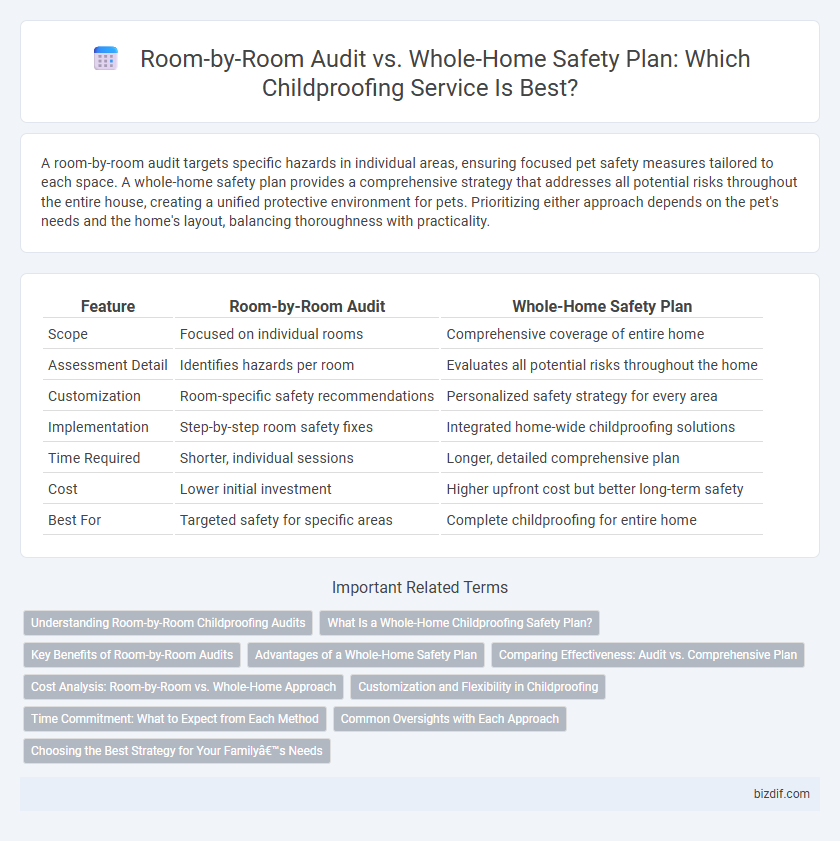A room-by-room audit targets specific hazards in individual areas, ensuring focused pet safety measures tailored to each space. A whole-home safety plan provides a comprehensive strategy that addresses all potential risks throughout the entire house, creating a unified protective environment for pets. Prioritizing either approach depends on the pet's needs and the home's layout, balancing thoroughness with practicality.
Table of Comparison
| Feature | Room-by-Room Audit | Whole-Home Safety Plan |
|---|---|---|
| Scope | Focused on individual rooms | Comprehensive coverage of entire home |
| Assessment Detail | Identifies hazards per room | Evaluates all potential risks throughout the home |
| Customization | Room-specific safety recommendations | Personalized safety strategy for every area |
| Implementation | Step-by-step room safety fixes | Integrated home-wide childproofing solutions |
| Time Required | Shorter, individual sessions | Longer, detailed comprehensive plan |
| Cost | Lower initial investment | Higher upfront cost but better long-term safety |
| Best For | Targeted safety for specific areas | Complete childproofing for entire home |
Understanding Room-by-Room Childproofing Audits
Room-by-room childproofing audits provide a detailed assessment of individual areas within the home, identifying specific hazards unique to each space such as sharp edges, choking hazards, or electrical outlets. This targeted approach allows for customized safety solutions that address particular risks, ensuring toys, furniture, and appliances comply with child safety standards. Compared to whole-home safety plans, room-by-room audits offer precise interventions that enhance both safety and functionality tailored to the child's developmental stage and household environment.
What Is a Whole-Home Childproofing Safety Plan?
A whole-home childproofing safety plan involves a comprehensive assessment of every room and potential hazard in the house to ensure maximum protection for children. Unlike a room-by-room audit that targets individual areas, this plan integrates safety measures throughout the entire home to address risks like sharp edges, electrical outlets, toxic substances, and unstable furniture. Implementing a whole-home childproofing safety plan minimizes accidents by creating a consistent, secure environment tailored to the child's developmental stages and movement patterns.
Key Benefits of Room-by-Room Audits
Room-by-room audits offer a detailed assessment tailored to each specific area, identifying unique hazards that might be overlooked in a whole-home plan. This targeted approach enhances precision in addressing risks, ensuring that childproofing measures are both effective and customized. By focusing on individual rooms, parents receive clear, actionable recommendations for immediate safety improvements.
Advantages of a Whole-Home Safety Plan
A whole-home safety plan offers comprehensive protection by addressing hazards in every room, ensuring consistent childproofing standards throughout the house. This approach reduces the risk of overlooked dangers that can occur when focusing on single rooms during a room-by-room audit. Coordinated implementation of safety measures enhances efficiency and provides a seamless environment tailored to a child's developmental needs.
Comparing Effectiveness: Audit vs. Comprehensive Plan
A room-by-room childproofing audit identifies specific hazards in individual areas, providing targeted solutions to address immediate risks. In contrast, a whole-home safety plan offers a comprehensive strategy that integrates childproofing measures throughout the entire residence, ensuring consistent protection across all spaces. Studies show that comprehensive plans reduce injury risks more effectively by addressing interconnected hazards and promoting long-term safety habits.
Cost Analysis: Room-by-Room vs. Whole-Home Approach
A room-by-room childproofing audit typically involves lower initial costs by targeting specific high-risk areas, allowing families to budget incrementally. In contrast, a whole-home safety plan requires a higher upfront investment but often reduces long-term expenses by addressing all potential hazards comprehensively, minimizing the need for repeated modifications. Cost analysis shows that whole-home approaches can offer better value through bundled services and materials, while room-by-room strategies provide flexibility for smaller budgets.
Customization and Flexibility in Childproofing
Room-by-room audits provide detailed insights tailored to each space's unique hazards, ensuring targeted childproofing solutions that address specific risks. Whole-home safety plans offer comprehensive coverage, adapting to the family's lifestyle and evolving needs with scalable childproofing options. Combining customization with flexibility maximizes protection and peace of mind throughout the entire home environment.
Time Commitment: What to Expect from Each Method
A room-by-room audit requires less initial time, typically completed in one to two hours per individual space, making it ideal for families seeking targeted safety improvements. A whole-home safety plan demands a more substantial time investment, often spanning several hours or multiple sessions, as it involves a comprehensive evaluation of every area to ensure consistent childproofing throughout the residence. Clients should weigh the urgency and extent of their safety needs when choosing between the quicker, focused approach and the thorough, all-encompassing strategy.
Common Oversights with Each Approach
Room-by-room audits often miss hazards that span multiple areas, such as wiring or toxic substances stored in shared spaces, leading to incomplete safety coverage. Whole-home safety plans may overlook specific room-based risks like individual furniture stability or localized choking hazards due to their broad focus. Combining both approaches ensures comprehensive identification and mitigation of common oversights in childproofing.
Choosing the Best Strategy for Your Family’s Needs
A room-by-room audit targets specific hazards in individual areas, making it ideal for families with limited time or budget who want to address the most pressing risks first. In contrast, a whole-home safety plan offers comprehensive protection by systematically identifying and mitigating dangers throughout the entire residence, ensuring consistent safety standards across all rooms. Evaluating factors like the child's age, home size, and lifestyle helps determine whether a focused audit or an all-encompassing plan best suits your family's safety priorities.
Room-by-room audit vs whole-home safety plan Infographic

 bizdif.com
bizdif.com